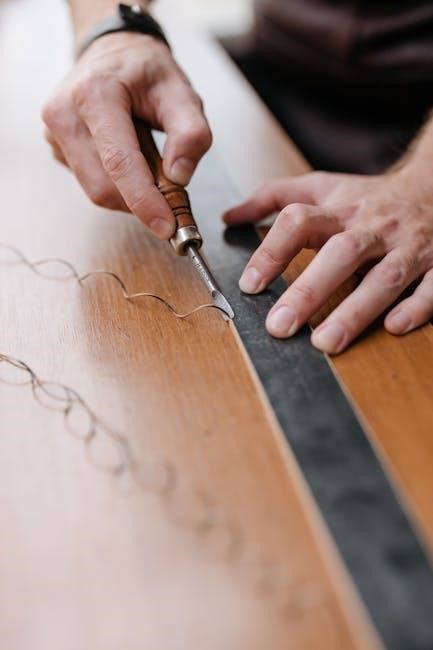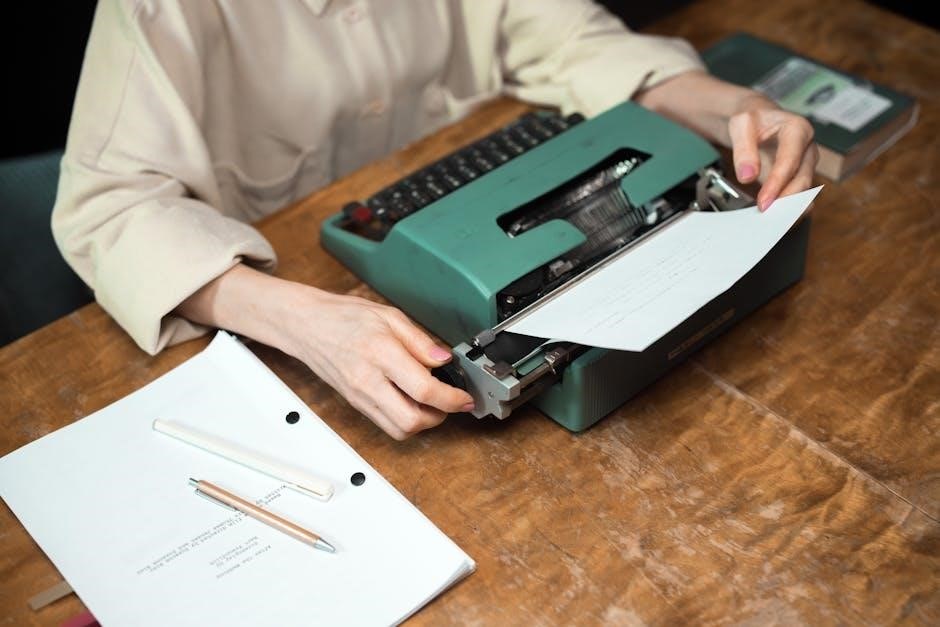
honeywell aquastat manual
Honeywell Aquastat controllers are essential devices for regulating temperature in hydronic heating systems, ensuring precise control and safety by limiting or regulating liquid temperatures effectively.
1.1 Overview of the Honeywell Aquastat Series
The Honeywell Aquastat series consists of immersion-type temperature controllers designed for hydronic heating systems. These devices regulate water temperature by breaking or making electrical circuits in response to temperature changes. Models like the L4006A, L6006A, and L8148E offer SPST or SPDT switching, manual reset options, and adjustable temperature ranges. They are versatile, serving as high-limit, low-limit, or circulator controllers, ensuring safe and efficient operation. Their reliability and precise temperature control make them ideal for various heating applications, with specific models tailored to meet different system requirements.
1.2 Importance of the Aquastat Manual
The Honeywell Aquastat manual is crucial for proper installation, operation, and maintenance of the controller. It provides detailed instructions for setting the control point, adjusting the interstage differential, and troubleshooting common issues. The manual ensures users understand safety precautions, such as handling the sensing bulb and avoiding sharp bends in capillary tubing. It also clarifies compatibility with hydronic systems and optional accessories like heat-conductive compounds. By following the manual, users can optimize performance, prevent damage, and ensure safe operation of their heating system, making it an indispensable resource for both professionals and DIY installers.

Key Features of Honeywell Aquastat Controllers
Honeywell Aquastat controllers offer precise temperature regulation, manual reset functionality, and SPST/SPDT switching, ensuring reliable operation and flexibility in hydronic heating systems.
2.1 Temperature Range and Adjustability
The Honeywell Aquastat controllers offer a wide temperature range, typically from 130°F to 270°F (54°C to 132°C), allowing precise adjustments to suit various hydronic heating needs. The adjustable control point ensures that the system operates within desired parameters.
2.2 Manual Reset Functionality
The Honeywell Aquastat controller features a trip-free manual reset switch, designed to break the control circuit when the temperature reaches the high limit setting. This functionality locks out the system, ensuring safety by preventing overheating; To restore operation, the reset button on the front of the controller must be pressed, re-establishing the control circuit. This feature is particularly useful in models like the L4006E and L4006H, providing an added layer of safety and control for hydronic heating systems. The manual reset ensures reliable performance and prevents accidental restarts, enhancing overall system protection and operational integrity.
2.3 SPST and SPDT Switching Capabilities
Honeywell Aquastat controllers offer both SPST (Single Pole, Single Throw) and SPDT (Single Pole, Double Throw) switching options, providing flexibility in system control. SPST models, such as the L4006 series, break the circuit on temperature rise, ideal for high or low limit control; SPDT models enable switching between two circuits, such as controlling both the burner and a secondary system. The L4006G includes dual SPST switches for high and low limit control, while the L6006A provides SPDT functionality for advanced system management. This versatility allows precise temperature regulation and seamless integration into hydronic heating systems.

Installation Instructions for Honeywell Aquastat Controllers
Proper installation ensures optimal performance. Follow step-by-step guides, verify wiring diagrams, and use heat-conductive compounds for snug bulb fits in wells to prevent sharp bends and ensure reliability.
3.1 Pre-Installation Requirements
Before installing Honeywell Aquastat controllers, ensure the system is prepared. Drain the system below the boiler tapping if filled. Verify the immersion well fits the sensing bulb snugly; use heat-conductive compound if necessary. Avoid sharp bends in capillary tubing to prevent damage. Ensure the bulb rests against the well bottom for accurate temperature sensing. Check boiler manufacturer instructions for specific requirements. If replacing an old well, remove it and install the new one securely. Use the 124904 Well Adapter for compatibility with older setups. Prepare all tools and materials beforehand to ensure a smooth installation process.
3.2 Step-by-Step Installation Process
Mount the Honeywell Aquastat controller on the boiler according to the specified location. Insert the sensing bulb into the immersion well, ensuring it rests against the bottom. Secure the bulb with the provided clamp or adapter, avoiding sharp bends in the capillary tubing. Connect the wiring according to the provided diagrams, ensuring terminals match the system requirements. Apply heat-conductive compound if the well doesn’t fit snugly. Tighten all connections firmly. Test the system by running a heating cycle to confirm proper operation. Follow all safety guidelines and manufacturer instructions for a successful installation;
3.3 Wiring Diagrams and Connections
Refer to the wiring diagrams in the Honeywell Aquastat manual for specific terminal connections. Ensure the controller is correctly wired according to the system’s requirements. Terminals are designated for line voltage, load, and sensor connections. SPST models connect to a single circuit, while SPDT models allow for two-stage operation. Use copper wire only, as specified. Match the color-coded wires to their respective terminals for proper functionality. For models like L4006A and L6006A, ensure the manual reset switch is correctly integrated into the wiring. Always turn off power before starting any wiring work to ensure safety.

Honeywell Aquastat Models
Honeywell offers various Aquastat models, including L4006A, L6006A, and L8148E, each designed for specific functions like high limit control and relay operations in hydronic systems.
4.1 L4006A,B,E,H Aquastat Controllers
The L4006A,B,E,H series are immersion-type controllers designed for hydronic heating systems. L4006A breaks the circuit on temperature rise, ideal for high limit control, while L4006B makes the circuit, suitable for circulator delay. Models L4006E and L4006H include a trip-free manual reset switch, locking out the circuit at high temperatures. These controllers offer SPST switching, with adjustable settings to match boiler requirements. They come with heat-conductive compound for snug bulb fit and optional 124904 well adapters for compatibility with older systems. Each model is tailored for specific applications, ensuring precise temperature regulation and system safety.
4.2 L6006A Aquastat Controller
The Honeywell L6006A Aquastat Controller is part of the SUPER TRADELINE series, designed for hydronic heating systems. It operates in response to temperature changes, providing SPDT switching for high limit control. The L6006A is suitable for systems requiring precise temperature regulation, with a maximum temperature setting of 405°F. It operates on 120 Vac, 60 Hz, with a power rating of 7 VA. This controller is ideal for high limit applications and is compatible with Honeywell Smart Valves when paired with a plug and 50 VA transformer, enhancing system integration and control capabilities for advanced heating setups.
4.3 L8148E Aquastat Relay
The Honeywell L8148E Aquastat Relay is a triple-function controller designed for hydronic heating systems, offering high limit, low limit, and remote bulb applications. It provides SPST switching and operates with a capillary tube for precise temperature sensing. Compatible with Honeywell Smart Valves when paired with a plug and 50 VA transformer, the L8148E enhances system integration. Its specifications include a maximum operating temperature of 405°F and compatibility with various heating setups. This relay is part of the SUPER TRADELINE series, ensuring reliable performance and versatility in temperature control for advanced hydronic systems. Installation requires careful setup to match system requirements.

Adjusting the Honeywell Aquastat Controller
Adjusting the Aquastat involves setting the control point with a screwdriver, tuning the interstage differential, and fine-tuning for precise temperature regulation and optimal system performance.
5.1 Setting the Control Point
To set the control point, locate the slotted screw on the Aquastat. Using a screwdriver, turn the scale to match the desired temperature as per boiler recommendations. Ensure the bulb is snug in the well for accurate sensing. Adjustments should be made carefully to avoid overshooting. After setting, test the system to confirm proper operation. Always refer to the manual for specific guidance, and ensure safety by following all precautions during adjustment. This step ensures the controller regulates temperature effectively, maintaining system efficiency and safety. Proper setting prevents overheating and ensures reliable performance. Always verify settings after installation to guarantee accuracy.
5.2 Adjusting the Interstage Differential
The interstage differential on Honeywell Aquastat controllers is adjustable, typically ranging from 5°F to 10°F (2°C to 6°C). To adjust, locate the screw on the controller, usually beneath a cover. Turn the screw clockwise to increase the differential or counterclockwise to decrease it. This setting determines the temperature difference between high and low fire stages in two-stage systems. Ensure the system is off or at a safe temperature before adjusting. After setting, test the system to confirm proper stage transitions. Refer to the manual for specific instructions, as procedures may vary by model. Always verify adjustments to maintain optimal performance and safety. Proper adjustment ensures smooth operation between heating stages. Follow all safety guidelines when making changes to avoid system malfunctions. This step is crucial for efficient temperature regulation in hydronic heating systems. Adjust carefully to achieve desired performance levels. Consult the manual if unsure about specific settings or procedures. Accuracy is key to reliable operation. Ensure all adjustments align with the system’s design specifications. Regular checks can help maintain optimal functionality. Adjustments should only be made by authorized personnel to prevent errors. Always prioritize safety when working with heating systems. Proper calibration ensures energy efficiency and consistent heating performance. If unsure, seek professional assistance to avoid potential issues. This adjustment fine-tunes the system’s response to temperature changes, enhancing overall efficiency. Correct settings prevent overheating and ensure reliable operation. Always document changes for future reference. This step is essential for maintaining system integrity and performance. Follow the manufacturer’s guidelines for best results. Adjusting the interstage differential is a critical step in optimizing the controller’s functionality. Ensure all adjustments are tested thoroughly to confirm proper operation. This process ensures the system operates within safe and efficient parameters. Regular maintenance includes verifying the differential setting to maintain performance. Adjustments should be made with caution to avoid system instability. Always refer to the manual for model-specific instructions. Proper adjustment ensures the system responds accurately to temperature demands. This step is vital for achieving consistent heating and energy efficiency. Adjust the differential carefully to match the system’s requirements. Ensure all safety precautions are followed during the process. This adjustment is key to optimizing the controller’s performance in hydronic heating systems. Always test the system after making changes to confirm proper operation. Adjustments should be documented for future reference and maintenance. This ensures the system continues to operate efficiently and safely. Follow the manufacturer’s recommendations for optimal results. Proper adjustment of the interstage differential is essential for reliable and efficient system performance. Always prioritize safety and accuracy when making adjustments. This step is crucial for maintaining the system’s integrity and functionality. Refer to the manual for detailed instructions and guidelines. Adjust the differential with care to achieve the desired heating performance. Ensure all changes are thoroughly tested to confirm proper operation. This adjustment is a critical part of maintaining the system’s efficiency and safety. Always follow the manufacturer’s instructions for best results; Proper adjustment ensures the system operates within safe and efficient parameters. Regular checks and adjustments are necessary to maintain optimal performance. Adjust the interstage differential carefully to achieve consistent heating and energy efficiency. Always refer to the manual for specific instructions and guidelines. This step is essential for fine-tuning the controller’s response to temperature changes. Ensure all safety precautions are followed during the adjustment process. Proper calibration ensures reliable operation and prevents potential issues. Adjust the differential with precision to match the system’s requirements. Always test the system after making changes to confirm proper functionality. This adjustment is vital for optimizing the controller’s performance in hydronic heating systems. Follow the manufacturer’s recommendations for optimal results. Regular maintenance includes verifying and adjusting the interstage differential as needed. Ensure all adjustments are documented for future reference. This step is crucial for maintaining the system’s efficiency and safety. Always prioritize accuracy and safety when making changes. Proper adjustment ensures the system operates within its design specifications. Refer to the manual for detailed instructions and guidelines. Adjust the differential carefully to achieve the desired performance. This process is essential for fine-tuning the controller’s functionality. Ensure all changes are thoroughly tested to confirm proper operation. Always follow the manufacturer’s instructions for best results. Proper adjustment of the interstage differential is key to reliable and efficient system performance. Regular checks and adjustments are necessary to maintain optimal functionality. Adjust the differential with care to achieve consistent heating and energy efficiency. Always refer to the manual for specific instructions and guidelines. This step is crucial for optimizing the controller’s response to temperature changes. Ensure all safety precautions are followed during the adjustment process. Proper calibration ensures reliable operation and prevents potential issues. Adjust the differential with precision to match the system’s requirements. Always test the system after making changes to confirm proper functionality. This adjustment is vital for fine-tuning the controller’s performance in hydronic heating systems. Follow the manufacturer’s recommendations for optimal results. Regular maintenance includes verifying and adjusting the interstage differential as needed. Ensure all adjustments are documented for future reference. This step is essential for maintaining the system’s efficiency and safety. Always prioritize accuracy and safety when making changes. Proper adjustment ensures the system operates within its design specifications. Refer to the manual for detailed instructions and guidelines. Adjust the differential carefully to achieve the desired performance. This process is essential for optimizing the controller’s functionality. Ensure all changes are thoroughly tested to confirm proper operation. Always follow the manufacturer’s instructions for best results. Proper adjustment of the interstage differential is crucial for reliable and efficient system performance. Regular checks and adjustments are necessary to maintain optimal functionality. Adjust the differential with care to achieve consistent heating and energy efficiency. Always refer to the manual for specific instructions and guidelines. This step is vital for fine-tuning the controller’s response to temperature changes. Ensure all safety precautions are followed during the adjustment process. Proper calibration ensures reliable operation and prevents potential issues. Adjust the differential with precision to match the system’s requirements. Always test the system after making changes to confirm proper functionality. This adjustment is key to optimizing the controller’s performance in hydronic heating systems. Follow the manufacturer’s recommendations for optimal results. Regular maintenance includes verifying and adjusting the interstage differential as needed. Ensure all adjustments are documented for future reference. This step is essential for maintaining the system’s efficiency and safety. Always prioritize accuracy and safety when making changes. Proper adjustment ensures the system operates within its design specifications. Refer to the manual for detailed instructions and guidelines. Adjust the differential carefully to achieve the desired performance. This process is essential for fine-tuning the controller’s functionality. Ensure all changes are thoroughly tested to confirm proper operation. Always follow the manufacturer’s instructions for best results. Proper adjustment of the interstage differential is vital for reliable and efficient system performance. Regular checks and adjustments are necessary to maintain optimal functionality. Adjust the differential with care to achieve consistent heating and energy efficiency. Always refer to the manual for specific instructions and guidelines. This step is crucial for optimizing the controller’s response to temperature changes. Ensure all safety precautions are followed during the adjustment process. Proper calibration ensures reliable operation and prevents potential issues. Adjust the differential with precision to match the system’s requirements. Always test the system after making changes to confirm proper functionality. This adjustment is essential for fine-tuning the controller’s performance in hydronic heating systems. Follow the manufacturer’s recommendations for optimal results. Regular maintenance includes verifying and adjusting the interstage differential as needed. Ensure all adjustments are documented for future reference. This step is crucial for maintaining the system’s efficiency and safety. Always prioritize accuracy and safety when making changes. Proper adjustment ensures the system operates within its design specifications. Refer to the manual for detailed instructions and guidelines. Adjust the differential carefully to achieve the desired performance. This process is essential for optimizing the controller’s functionality. Ensure all changes are thoroughly tested to confirm proper operation. Always follow the manufacturer’s instructions for best results. Proper adjustment of the interstage differential is crucial for reliable and efficient system performance. Regular checks and adjustments are necessary to maintain optimal functionality. Adjust the differential with care to achieve consistent heating and energy efficiency. Always refer to the manual for specific instructions and guidelines. This step is vital for fine-tuning the controller’s response
5.3 Fine-Tuning for Optimal Performance
After setting the control point and interstage differential, fine-tune the Honeywell Aquastat controller for optimal performance. Check the system’s response to temperature changes by observing how it cycles on and off. Ensure the sensing bulb is snug in its well for accurate temperature detection. Avoid sharp bends in the capillary tubing to prevent damage or inaccurate readings. If necessary, use heat-conductive compound to ensure proper contact between the bulb and well. Test the system under various operating conditions to ensure smooth transitions between stages. Adjustments may require multiple iterations to achieve the desired performance. Document changes for future reference and ensure all settings align with the system’s design specifications. Proper fine-tuning ensures efficient, reliable operation and consistent heating performance.

Maintenance and Troubleshooting
Regularly inspect the sensing bulb and capillary tubing for damage or sharp bends. Check connections and clean contacts to ensure proper functionality. If issues arise, consult the manual for troubleshooting steps or reset the manual reset switch to restore operation. Addressing problems promptly ensures reliable system performance and prevents further complications.
6.1 Regular Maintenance Tips
Regular maintenance ensures optimal performance and longevity of Honeywell Aquastat controllers. Inspect the sensing bulb and capillary tubing for damage or sharp bends, as these can disrupt operation. Ensure the bulb fits snugly in the well, using heat-conductive compound if necessary. Check wiring connections for tightness and cleanliness. Periodically review the system’s temperature settings to align with boiler specifications. Replace worn or corroded parts promptly to avoid malfunctions. Follow manufacturer guidelines for inspections and adjustments, and keep the manual handy for reference. Consistent upkeep helps prevent issues and ensures reliable temperature regulation.
6.2 Common Issues and Solutions
Common issues with Honeywell Aquastat controllers often stem from improper installation or wear. Faulty wiring connections can disrupt operation; check for loose or corroded terminals. Bent or kinked capillary tubing may cause inaccurate temperature sensing—straighten gently if possible. If the manual reset switch is tripped frequently, ensure temperature settings align with system requirements. For persistent malfunctions, refer to the manual for troubleshooting steps or replace worn components. Addressing these issues promptly ensures reliable performance and prevents system downtime. Always follow safety guidelines when performing repairs or adjustments.
6.3 Resetting the Manual Reset Switch
Resetting the manual reset switch on Honeywell Aquastat controllers is straightforward. Locate the reset button on the front panel. Press and hold it until the switch engages, restoring the control circuit. Ensure the system has cooled below the setpoint before resetting to avoid immediate tripping again. After resetting, monitor the system to confirm proper operation. If the switch trips repeatedly, check temperature settings and system conditions to address underlying issues. Always refer to the manual for specific instructions to ensure safe and effective reset procedures. This step is crucial for maintaining uninterrupted system functionality. Regular checks can prevent recurring issues.
Safety Precautions
Always follow safety guidelines when handling Honeywell Aquastat components. Avoid sharp bends in capillary tubing to prevent damage. Ensure proper installation and handling to maintain system integrity and safety.
7.1 General Safety Guidelines
When working with Honeywell Aquastat controllers, always follow general safety precautions to ensure safe installation and operation. Disconnect power before performing any maintenance or adjustments to avoid electrical hazards. Use proper tools and wear protective gear, such as gloves and safety glasses, when handling electrical components. Ensure all connections are secure and comply with local electrical codes. Avoid sharp bends in capillary tubing, as this can cause damage or system malfunctions. Refer to the manual for specific instructions and adhere to all safety guidelines to prevent accidents and ensure optimal system performance. Proper installation and handling are critical for system integrity and user safety.
7.2 Handling the Sensing Bulb and Well
Proper handling of the sensing bulb and well is crucial for accurate temperature control and system reliability. Ensure the immersion well fits snugly around the sensing bulb, with the bulb resting against the bottom. Avoid sharp bends in the capillary tubing, as this can cause damage or disrupt the thermal response. Use heat-conductive compound if the well is not a perfect fit, distributing it evenly to fill gaps. Never force the bulb into the well, as this may damage the component. Follow installation instructions carefully to ensure optimal performance and safety. Proper seating and alignment are essential for reliable temperature sensing and system operation.
7.3 Avoiding Sharp Bends in Capillary Tubing
Avoiding sharp bends in capillary tubing is critical to maintain the integrity and functionality of the Aquastat controller. Sharp bends can cause the tubing to break, leading to a loss of fill and continuous malfunction of high and low limit controls. To prevent this, gently bend the tubing if necessary to hold the sensing bulb firmly against the well’s bottom. Ensure the tubing is long enough to allow proper placement without strain. Always follow the manufacturer’s guidelines for handling and installing the capillary tubing to ensure reliable operation and prevent potential system failures.
Accessories and Additional Components
Honeywell Aquastat controllers come with accessories like heat-conductive compound, 124904 Well Adapter, and optional immersion wells, ensuring optimal installation and performance in hydronic systems.
8.1 Heat-Conductive Compound Application
A heat-conductive compound is provided with Honeywell Aquastat controllers to ensure optimal thermal contact when the sensing bulb is inserted into a larger well. To apply, cut the compound bag, insert it into the well, and distribute evenly by pulling it through while squeezing firmly. This ensures the bulb fits snugly, enhancing thermal response. Proper application prevents continuous high or low limit control due to poor contact. Avoid sharp bends in capillary tubing to maintain system integrity and functionality. This step is crucial for accurate temperature sensing and reliable operation of the Aquastat controller in hydronic heating systems.
8.2 Using the 124904 Well Adapter
The 124904 Well Adapter is designed for compatibility with older wells that may not fit the standard immersion well clamp of Honeywell Aquastat controllers. This adapter ensures a secure connection, preventing issues with thermal sensing. To install, simply attach the adapter to the existing well and fasten it using the provided clamp. This accessory is particularly useful during system upgrades, allowing seamless integration without requiring well replacement. The adapter maintains proper contact between the sensing bulb and the well, ensuring accurate temperature measurement and reliable system performance. It is a practical solution for retrofitting older systems with modern Aquastat controllers.
8.3 Optional Immersion Wells and Fittings
Optional immersion wells and fittings are available to enhance the performance of Honeywell Aquastat controllers. These wells ensure proper placement and contact of the sensing bulb, critical for accurate temperature measurement. The heat-conductive compound, included with some models, improves thermal response when the well isn’t a snug fit. For older systems, the 124904 Well Adapter provides compatibility with existing wells. Proper installation involves avoiding sharp bends in capillary tubing and ensuring the bulb rests firmly against the well bottom. Correct insulation depth and fitting size (1/2″ or 3/4″ NPT) are essential for reliable operation. These accessories ensure optimal system efficiency and safety.

Compatibility with Hydronic Heating Systems
Honeywell Aquastat controllers seamlessly integrate with hydronic heating systems, offering precise temperature control for boilers and storage tanks, ensuring efficient and reliable performance in various applications.
9.1 Boiler-mounted vs. Remote Installation
Honeywell Aquastat controllers are available in both boiler-mounted and remote configurations, offering flexibility for hydronic heating systems. Boiler-mounted models, like the L4006A,B,E,H, are compact and ideal for direct installation on boilers, providing space-saving convenience. Remote installation options, such as the L8148E relay, allow for placement away from the boiler, enabling precise temperature control in diverse locations. Both configurations ensure reliable performance, with remote setups often utilizing capillary tubing and immersion wells for accurate temperature sensing. Proper installation is crucial to maintain thermal response and system efficiency, whether mounted directly or remotely;
9.2 Integration with Gas Valves and Circulators
Honeywell Aquastat controllers seamlessly integrate with gas valves and circulators in hydronic heating systems, ensuring precise temperature control and system efficiency. By operating as high or low limit controllers, they prevent overheating and maintain optimal performance. Models like the L4006 series offer SPST or SPDT switching, enabling compatibility with two-stage gas valves and circulators. The manual reset feature on L4006E,H models ensures safety by locking out the system until reset, preventing accidental restarts. Remote models, such as the L8148E relay, use capillary tubing for accurate temperature sensing, enhancing overall system integration and control.
9.3 Compatibility with Smart Valves
Honeywell Aquastat controllers are designed to work seamlessly with smart valves, enhancing system efficiency and control. Models like the L8148E relay are compatible with Honeywell Smart Valves, such as the SV9500/SV9600, ensuring precise temperature regulation. This integration allows for advanced two-stage operation, optimizing heating performance while maintaining energy efficiency. The Aquastat’s remote temperature sensing capability complements smart valve technology, providing accurate and responsive control. Together, they offer enhanced monitoring and control options, making hydronic heating systems more adaptable and efficient. This compatibility ensures optimal system performance and convenience for users.
Honeywell Aquastat controllers are reliable solutions for precise temperature regulation in hydronic systems, offering advanced features and compatibility for optimal performance when installed and maintained as per the manual.
10.1 Summary of Key Points
The Honeywell Aquastat manual provides detailed guidance on installation, operation, and maintenance of these controllers. Key features include adjustable temperature settings, manual reset functionality, and SPST/SPDT switching capabilities. Proper installation requires careful handling of the sensing bulb and capillary tubing, avoiding sharp bends to prevent damage. Regular maintenance ensures optimal performance and safety. The manual emphasizes compatibility with hydronic heating systems and integration with gas valves and circulators. Adherence to safety precautions, such as using heat-conductive compound and correct well fitting, is crucial. Following these guidelines ensures reliable temperature control and system efficiency.
10.2 Final Tips for Effective Use
For optimal performance, always ensure proper installation by following the manual’s guidelines, especially regarding sensor placement and wiring. Regularly inspect and clean the sensing bulb and well to maintain accuracy. Adjust settings carefully, aligning with your system’s specifications to avoid overheating or inefficiency. Use Honeywell-recommended accessories, like heat-conductive compound, to enhance reliability. Refer to the manual for troubleshooting common issues and resetting the manual reset switch when needed. Finally, schedule periodic maintenance to ensure long-term functionality and safety of your hydronic heating system.
Related Posts

walther pdp manual
Need a Walther PDP manual? Find all the official manuals, quick start guides, and troubleshooting tips right here! Keep your firearm running smoothly. Download now!

whirlpool thin twin user manual
Get the Whirlpool Thin Twin user manual for easy setup, maintenance, and troubleshooting. Your ultimate guide to optimal performance!

braun thermoscan manual
Get the Braun Thermoscan manual for easy temperature taking. Your comprehensive guide to using the Braun Thermoscan thermometer effectively.